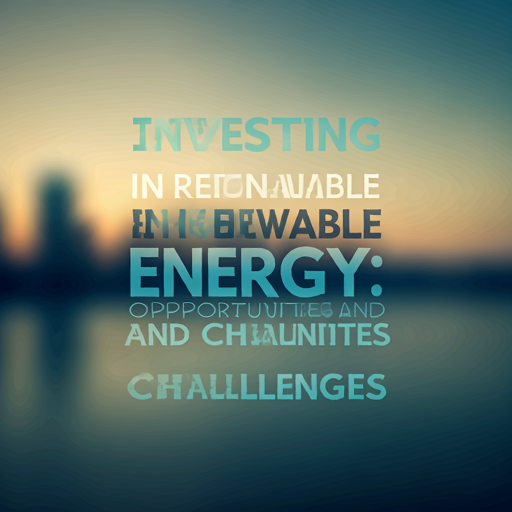Introduction to Renewable Energy and Cryptocurrency
Overview of Renewable Energy Sources
Renewable energy sources, such as solar, wind, and hydroelectric power, are gaining traction in the global market. These resources offer sustainable alternatives to fossil fuels, reducing carbon footprints. Investors are increasingly drawn to these sectors due to their potential for long-term returns. It’s a smart move. Additionally, the integration of cryptocurrency into renewable energy markets is creating innovative financing solutions. This synergy can enhance liquidity and facilitate decentralized energy trading. Isn’t that fascinating? As tge demand for clean energy rises, so does the opportunity for financial growth. The future looks bright.
The Role of Cryptocurrency in Energy Markets
Cryptocurrency is revolutionizing energy markets by enabling peer-to-peer transactions and enhancing transparence. This innovation reduces reliance on traditional intermediaries. It’s a game changer. Moreover, blockchain technology facilitates real-time tracking of energy pfoduction and consumption. This leads to more efficient resource allocation. Isn’t that impressive? As a result, investors can capitalize on decentralized energy solutions. The potential for profit is significant. The landscape is evolving rapidly.
Investment Opportunities in Renewable Energy
Emerging Technologies and Innovations
Emerging technologies in renewable energy present significant investment opportunities. Innovations such as advanced solar panels and energy storage systems enhance efficiency. This leads to higher returns. Additionally, smart grid technology optimizes energy distribution, reducing waste. Investors can benefit from these advancements. The market is ripe for disruption. He should consider diversifying his portfolio. The potential for growth is substantial.
Government Incentives and Support
Government incentives play a crucial role in promoting renewable energy investments. These incentives often include tax credits, grants, and subsidies. Such financial support reduces initial capital costs. This makes projects more attractive. Furthermore, regulatory frameworks are increasingly favorable, encouraging private sector participation. Investors can buoy leverage these conditions for better returns . He should stay informed about policy changes.
Challenges Facing Renewable Energy Investments
Market Volatility and Price Fluctuations
Market volatility and price fluctuations pose significant challenges for renewable energy investments. These factors can lead to unpredictable returns, complicating financial planning. Investors must navigate these uncertainties carefully. It can be stressful. Additionally, external influences such as geopolitical dvents and regulatory changes can exacerbate price instability. He should remain vigilant about market trends. Understanding these dynamics is essential for informed decision-making. Knowledge is power.
Regulatory and Compliance Issues
Regulatory and compliance issues significantly impact renewable energy investments. These challenges can include:
Navigating these regulations can be time-consuming. He must allocate resources effectively. Additionally, changes in policy can create uncertainty in the securities industry. This unpredictability can deter potential investors. Understanding the regulatory landscape is crucial for success . Knowledge is essential for informed decisions.
Cryptocurrency’s Impact on Renewable Energy Adoption
Decentralized Energy Trading Platforms
Decentralized energy trading platforms are transforming the renewable energy landscape. These platforms enable peer-to-peer transactions, enhancing market efficiency. This reduces reliance on traditional utilities. It’s a significant shift. Furthermore, they facilitate real-time energy trading, allowing consumers to buy and sell excess energy. This creates new revenue streams. Investors can capitalize on these innovative solutions.
Tokenization of Renewable Energy Assets
Tokenization of renewable energy assets allows for fractional ownership and increased liquidity. This process converts physical assets into digital tokens on a blockchain. It simplifies investment in renewable projects. Investors can diversify their portfolios easily. Additionally, tokenization enhances transparency in transactions. This builds trust among stakeholders. The market can become more accessible. He should consider these opportunities. The future of investment is changing.
Case Studies of Successful Investments
Notable Projects in the Renewable Sector
Notable projects in the renewable sector demonstrate successful investment strategies. For instance, the Hornsea One offshore wind farm in the UK has become a benchmark for large-scale wind energy. It generates enough power for over one million homes. This is impressive. Similarly, the Tesla Gigafactory focuses on battery production, enhancing energy storage capabilities. This innovation supports renewable energy integration. Investors can learn from these examples. They highlight the potential for substantial returns. The future looks promising.
Lessons Learned from Failed Ventures
Lessons learned from failed ventures provide valuable insights. For example, the Solyndra solar panel company collapsed due to high production costs and market competition. This failure highlights the importance of cost management. He should prioritize efficiency. Another case is the failure of the Cape Wind project, which faced regulatory hurdles and community opposition. Understanding stakeholder engagement is crucial. These examples emphasize the need for thorough market analysis. Knowledge is essential for future success.
The Future of Renewable Energy and Cryptocurrency
Predictions for Market Growth
Predictions for market growth in renewable energy and cryptocurrency are optimistic. Analysts forecast significant increases in investment over the next decade. This trend reflects growing consumer demand for sustainable solutions. It’s a positive shift. Additionally, advancements in technology will enhance efficiency and reduce costs. This will attract more investors. The integration of blockchain in energy markets is also expected to facilitate transactions. He should monitor these developments closely. The potential for innovation is immense.
Strategies for Investors Moving Forward
Investors should adopt diversified strategies to navigate the evolving landscape of renewable energy and cryptocurrency. Focusing on emerging technologies can yield significant returns. He must stay informed about market trends. Additionally, investing in decentralized energy platforms can enhance portfolio resilience. This approach mitigates risks associated with traditional energy markets. Engaging with regulatory developments is also crucial for informed decision-making. He should consider long-term investments in sustainable projects. The future is promising.
